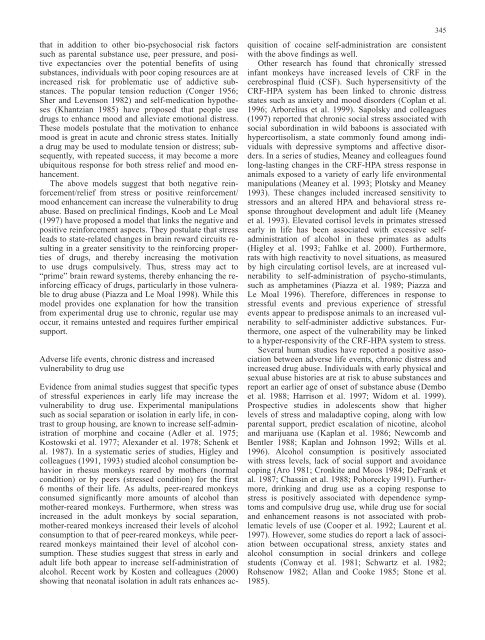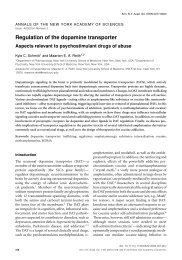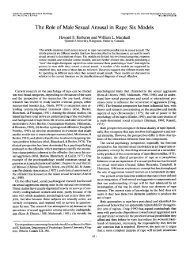How does stress increase risk of drug abuse - Addiction Research ...
How does stress increase risk of drug abuse - Addiction Research ...
How does stress increase risk of drug abuse - Addiction Research ...
You also want an ePaper? Increase the reach of your titles
YUMPU automatically turns print PDFs into web optimized ePapers that Google loves.
that in addition to other bio-psychosocial <strong>risk</strong> factors<br />
such as parental substance use, peer pressure, and positive<br />
expectancies over the potential benefits <strong>of</strong> using<br />
substances, individuals with poor coping resources are at<br />
<strong>increase</strong>d <strong>risk</strong> for problematic use <strong>of</strong> addictive substances.<br />
The popular tension reduction (Conger 1956;<br />
Sher and Levenson 1982) and self-medication hypotheses<br />
(Khantzian 1985) have proposed that people use<br />
<strong>drug</strong>s to enhance mood and alleviate emotional di<strong>stress</strong>.<br />
These models postulate that the motivation to enhance<br />
mood is great in acute and chronic <strong>stress</strong> states. Initially<br />
a <strong>drug</strong> may be used to modulate tension or di<strong>stress</strong>; subsequently,<br />
with repeated success, it may become a more<br />
ubiquitous response for both <strong>stress</strong> relief and mood enhancement.<br />
The above models suggest that both negative reinforcement/relief<br />
from <strong>stress</strong> or positive reinforcement/<br />
mood enhancement can <strong>increase</strong> the vulnerability to <strong>drug</strong><br />
<strong>abuse</strong>. Based on preclinical findings, Koob and Le Moal<br />
(1997) have proposed a model that links the negative and<br />
positive reinforcement aspects. They postulate that <strong>stress</strong><br />
leads to state-related changes in brain reward circuits resulting<br />
in a greater sensitivity to the reinforcing properties<br />
<strong>of</strong> <strong>drug</strong>s, and thereby increasing the motivation<br />
to use <strong>drug</strong>s compulsively. Thus, <strong>stress</strong> may act to<br />
“prime” brain reward systems, thereby enhancing the reinforcing<br />
efficacy <strong>of</strong> <strong>drug</strong>s, particularly in those vulnerable<br />
to <strong>drug</strong> <strong>abuse</strong> (Piazza and Le Moal 1998). While this<br />
model provides one explanation for how the transition<br />
from experimental <strong>drug</strong> use to chronic, regular use may<br />
occur, it remains untested and requires further empirical<br />
support.<br />
Adverse life events, chronic di<strong>stress</strong> and <strong>increase</strong>d<br />
vulnerability to <strong>drug</strong> use<br />
Evidence from animal studies suggest that specific types<br />
<strong>of</strong> <strong>stress</strong>ful experiences in early life may <strong>increase</strong> the<br />
vulnerability to <strong>drug</strong> use. Experimental manipulations<br />
such as social separation or isolation in early life, in contrast<br />
to group housing, are known to <strong>increase</strong> self-administration<br />
<strong>of</strong> morphine and cocaine (Adler et al. 1975;<br />
Kostowski et al. 1977; Alexander et al. 1978; Schenk et<br />
al. 1987). In a systematic series <strong>of</strong> studies, Higley and<br />
colleagues (1991, 1993) studied alcohol consumption behavior<br />
in rhesus monkeys reared by mothers (normal<br />
condition) or by peers (<strong>stress</strong>ed condition) for the first<br />
6 months <strong>of</strong> their life. As adults, peer-reared monkeys<br />
consumed significantly more amounts <strong>of</strong> alcohol than<br />
mother-reared monkeys. Furthermore, when <strong>stress</strong> was<br />
<strong>increase</strong>d in the adult monkeys by social separation,<br />
mother-reared monkeys <strong>increase</strong>d their levels <strong>of</strong> alcohol<br />
consumption to that <strong>of</strong> peer-reared monkeys, while peerreared<br />
monkeys maintained their level <strong>of</strong> alcohol consumption.<br />
These studies suggest that <strong>stress</strong> in early and<br />
adult life both appear to <strong>increase</strong> self-administration <strong>of</strong><br />
alcohol. Recent work by Kosten and colleagues (2000)<br />
showing that neonatal isolation in adult rats enhances ac-<br />
345<br />
quisition <strong>of</strong> cocaine self-administration are consistent<br />
with the above findings as well.<br />
Other research has found that chronically <strong>stress</strong>ed<br />
infant monkeys have <strong>increase</strong>d levels <strong>of</strong> CRF in the<br />
cerebrospinal fluid (CSF). Such hypersensitivty <strong>of</strong> the<br />
CRF-HPA system has been linked to chronic di<strong>stress</strong><br />
states such as anxiety and mood disorders (Coplan et al.<br />
1996; Arborelius et al. 1999). Sapolsky and colleagues<br />
(1997) reported that chronic social <strong>stress</strong> associated with<br />
social subordination in wild baboons is associated with<br />
hypercortisolism, a state commonly found among individuals<br />
with depressive symptoms and affective disorders.<br />
In a series <strong>of</strong> studies, Meaney and colleagues found<br />
long-lasting changes in the CRF-HPA <strong>stress</strong> response in<br />
animals exposed to a variety <strong>of</strong> early life environmental<br />
manipulations (Meaney et al. 1993; Plotsky and Meaney<br />
1993). These changes included <strong>increase</strong>d sensitivity to<br />
<strong>stress</strong>ors and an altered HPA and behavioral <strong>stress</strong> response<br />
throughout development and adult life (Meaney<br />
et al. 1993). Elevated cortisol levels in primates <strong>stress</strong>ed<br />
early in life has been associated with excessive selfadministration<br />
<strong>of</strong> alcohol in these primates as adults<br />
(Higley et al. 1993; Fahlke et al. 2000). Furthermore,<br />
rats with high reactivity to novel situations, as measured<br />
by high circulating cortisol levels, are at <strong>increase</strong>d vulnerability<br />
to self-administration <strong>of</strong> psycho-stimulants,<br />
such as amphetamines (Piazza et al. 1989; Piazza and<br />
Le Moal 1996). Therefore, differences in response to<br />
<strong>stress</strong>ful events and previous experience <strong>of</strong> <strong>stress</strong>ful<br />
events appear to predispose animals to an <strong>increase</strong>d vulnerability<br />
to self-administer addictive substances. Furthermore,<br />
one aspect <strong>of</strong> the vulnerability may be linked<br />
to a hyper-responsivity <strong>of</strong> the CRF-HPA system to <strong>stress</strong>.<br />
Several human studies have reported a positive association<br />
between adverse life events, chronic di<strong>stress</strong> and<br />
<strong>increase</strong>d <strong>drug</strong> <strong>abuse</strong>. Individuals with early physical and<br />
sexual <strong>abuse</strong> histories are at <strong>risk</strong> to <strong>abuse</strong> substances and<br />
report an earlier age <strong>of</strong> onset <strong>of</strong> substance <strong>abuse</strong> (Dembo<br />
et al. 1988; Harrison et al. 1997; Widom et al. 1999).<br />
Prospective studies in adolescents show that higher<br />
levels <strong>of</strong> <strong>stress</strong> and maladaptive coping, along with low<br />
parental support, predict escalation <strong>of</strong> nicotine, alcohol<br />
and marijuana use (Kaplan et al. 1986; Newcomb and<br />
Bentler 1988; Kaplan and Johnson 1992; Wills et al.<br />
1996). Alcohol consumption is positively associated<br />
with <strong>stress</strong> levels, lack <strong>of</strong> social support and avoidance<br />
coping (Aro 1981; Cronkite and Moos 1984; DeFrank et<br />
al. 1987; Chassin et al. 1988; Pohorecky 1991). Furthermore,<br />
drinking and <strong>drug</strong> use as a coping response to<br />
<strong>stress</strong> is positively associated with dependence symptoms<br />
and compulsive <strong>drug</strong> use, while <strong>drug</strong> use for social<br />
and enhancement reasons is not associated with problematic<br />
levels <strong>of</strong> use (Cooper et al. 1992; Laurent et al.<br />
1997). <strong>How</strong>ever, some studies do report a lack <strong>of</strong> association<br />
between occupational <strong>stress</strong>, anxiety states and<br />
alcohol consumption in social drinkers and college<br />
students (Conway et al. 1981; Schwartz et al. 1982;<br />
Rohsenow 1982; Allan and Cooke 1985; Stone et al.<br />
1985).










